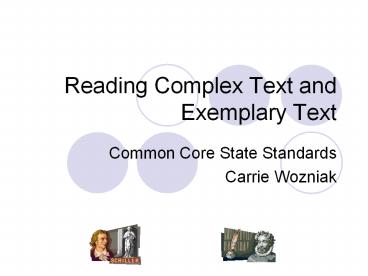Reading Complex Text and Exemplary Text - PowerPoint PPT Presentation
1 / 25
Title:
Reading Complex Text and Exemplary Text
Description:
Reading Complex Text and Exemplary Text Common Core State Standards Carrie Wozniak Reading One of the key requirements of the Common Core State Standards for Reading ... – PowerPoint PPT presentation
Number of Views:157
Avg rating:3.0/5.0
Title: Reading Complex Text and Exemplary Text
1
Reading Complex Text and Exemplary Text
- Common Core State Standards
- Carrie Wozniak
2
Reading
- One of the key requirements of the Common Core
State Standards for Reading is that all students
must be able to comprehend texts of steadily
increasing complexity as they progress through
school. - By the time they complete the core, students
must be able to read and comprehend independently
and proficiently the kinds of complex texts
commonly found in college and careers.
3
- The first part of this section makes a
research-based case for why the complexity of
what students read matters. In brief, while
reading demands in college, workforce training
programs, and life in general have held steady or
increased over the last half century, K12 texts
have actually declined in sophistication, and
relatively little attention has been paid to
students ability to read complex texts
independently. - These conditions have left a serious gap between
many high school seniors reading ability and the
reading requirements they will face after
graduation.
4
Does this scene look familiar?
- http//cooperativelearning.learnhub.com/lesson/959
2-seinfeld-teaches-history
5
Are these students ready for the ACT?Can they
read complex text?
- Probably not . . .
- fact focused and repositories of information
6
- What chiefly distinguished the performance of
those students who had earned the benchmark score
or better from those who had not was not their
relative ability in making inferences while
reading or answering questions related to
particular cognitive processes, such as
determining main ideas or determining the meaning
of words and phrases in context.
7
- Instead, the clearest differentiator was
students ability to answer questions associated
with complex texts. - Students scoring below benchmark performed no
better than chance (25 percent correct) on
four-option multiple-choice questions pertaining
to passages rated as complex on a three-point
qualitative rubric described in the report.
8
(No Transcript)
9
(No Transcript)
10
(No Transcript)
11
- Performance on complex texts is the clearest
differentiator in reading between students who
are likely to be ready for college and those who
are not. - And this is true for both genders, all
racial/ethnic groups, and all annual family
income levels. - - ACT Reading Between the Lines
12
- The second part of this section addresses how
text complexity can be measured and made a
regular part of instruction. - It introduces a three-part model that blends
qualitative and quantitative measures of text
complexity with reader and task considerations.
13
What is complex text?
Page 4
14
Turn and Talk
- Identify the four qualitative factors for
measuring complex text. - Think about a text you are currently teaching and
apply the four factors to that text. Where does
it fall?
15
Quantitative Factors
- OKAPI! is a web-based application that allows you
to enter a text sample and to format that sample
as a set of Examiner and Student Curriculum-Based
Assessment (CBA) reading probes. The application
also computes a readability index for the sample.
OKAPI! can save you hours of work in creating
correctly formatted CBA reading probes that
include estimates of reading level.OKAPI! gives
you a range of options. You can for example
change the font-type and letter-size for the CBA
probes. Additionally, you can specify that either
the Spache or Dale-Chall Readability Formula be
used to compute a passage's readability index.
16
- http//www.lefthandlogic.com/htmdocs/tools/okapi/o
kapi.php - Easier to just google OKAPI!
17
Grades 4-5
- Alice was beginning to get very tired of sitting
by her sister on the bank, and of having nothing
to do once or twice she had peeped into the book
her sister was reading, but it had no pictures or
conversations in it, 'and what is the useof a
book,' thought Alice 'without pictures or
conversation?'
18
Readers and Tasks
- Students ability to read complex text does not
always develop in a linear fashion. Although the
progression of Reading Standard 10 defines
required grade-by-grade growth in students
ability to read complex text, the development of
this ability in individual students is unlikely
to occur at an unbroken pace. - Students need opportunities to stretch their
reading abilities but also to experience the
satisfaction and pleasure of easy, fluent reading
within them, both of which the Standards allow
for.
19
- Such factors as students motivation, knowledge,
and experiences must also come into play in text
selection. Students deeply interested in a given
topic, for example, may engage with texts on that
subject across a range of complexity. - Particular tasks may also require students to
read harder texts than they would normally be
required to. - Conversely, teachers who have had success using
particular texts that are easier than those
required for a given grade band should feel free
to continue to use them so long as the general
movement during a given school year is toward
texts of higher levels of complexity.
20
Think about Your students.
21
Pages 11-16
- The section concludes with three annotated
examples showing how the model can be used to
assess the complexity of various kinds of texts
appropriate for different grade levels.
22
(No Transcript)
23
Appendix B
24
Lets take a look . . .
- Find your grade band.
- With a partner, select a text exemplar to read
and review. - Reflect on the big three
- Quantitative Analysis
- Qualitative Analysis
- Reader and Task
- Where do your students fit?
25
Think about . . .
- How will the Common Core Reading Standards Impact
your decisions on text?






























